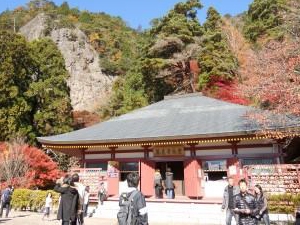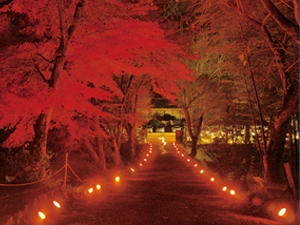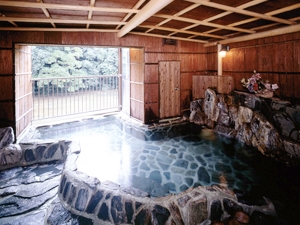
The mountain itself is unique, with unusual geological features, rocks and mineral formations. Rare birds, such as the Japanese Scops Owl can be found here, and are seen as sacred, as their hooting call of “Bu-po-so” is said to mean Bu=Buddha, Po=sutra, So=priest. Flying squirrels also make their home on the holy mountain. Rare ferns, lilies and other vegetation growing amongst the dense, ancient forest of giant cedar and Japanese cypress add to the feeling of being somewhere special.
There are 1,425 uneven, unstable, often slippery, rustic winding steps leading to the Cliffside temple of Horaiji. The temple gives the mountain its name, Mt. Horaiji. The mountainside and the path to the top is dotted with small shrines and statues of various deities, and the remains of former buildings which once served the Horaiji complex.
Power Spot, and People of Power

Built halfway up the mountainside, below a massive sheer stone cliff face is the temple and precincts. Founded in the year 703 by the hermit priest Rishu, Horaiji Temple has long been patronized by the likes of the first of the Kamakura shogun, the mighty Minamoto Yoritomo, the powerful 16th century warrior, Takeda Shingen, 17th century ruler Shogun Tokugawa Ieyasu and his grandson, Iemitsu. The wandering poet, Matsuo Basho is also said to have visited the mountain on his travels. Dedicated to the Yakushi-Nyorai, the Healing Buddha, a powerful deity able to cure diseases and illness, Horaiji Temple received many pilgrims seeking cures for their physical and mental ailments and spiritual enhancement, particularly during the Edo period. Even to this day the temple and mountain attracts many seeking inner peace and amazing views. Indeed, the view from the top is stunning, across the Mikawa Bay and the Mikawa region. Autumn brings forth some incredible scenes.

As a power spot, it is said that you can gain strength and spiritual power from the sun being reflected off the cliff face simply by standing in front of it.
Just east of the main hall is the Tokugawa dedicated Toshogu Shrine, built by the third Shogun, Iemitsu. The walls of the Toshogu feature gorgeous, intricate carvings like those of the Nikko Toshogu. The Nio Gate, also constructed by Iemitsu is a National Important Cultural Property too.
The holy mountain and its precincts are said to share lay-lines and intersection points with a number of important shrines, temples, castles and even Mt. Fuji, adding to the mysticism of Horaiji Temple. Tokugawa Ieyasu’s parents are said to have prayed here prior to his conception, and many claim miraculous cures following their pilgrimage to the temple and the hot springs below.
Legend of Horaiji Temple

Legend tells that the mystic monk Rishu discovered a natural hot spring in the Yuya Valley below the mountain. At the time, the Emperor Mommu was said to been very ill, and so Rishu, trained in the Buddhist art of healing, was called upon to find a cure. Rishu was carried to the Imperial Palace by a phoenix, and spent 17 days and nights praying until the emperor made a recovery. In gratitude, Emperor Mommu established the temple of Horaiji. (Incidentally, the name Horaiji translates to Temple of the Coming Phoenix)
The temple was built in the auspicious location below the cliff face, which made it a little inconvenient for Rishu to visit the medicinal hot springs below, and so with his holy robes flapping in the wind, he would levitate down the mountain while playing his flute. Stories of the supernatural priests’ visits to the hot springs prompted locals to establish inns and bathhouses at the site, a practice which continues to this day.
Come for the views, come for the history and the legends, come for your own spiritual awakening, just come for the experience and see for yourself, the Horaiji Temple, on holy Mt. Horaiji.




































 Keyword
Keyword







